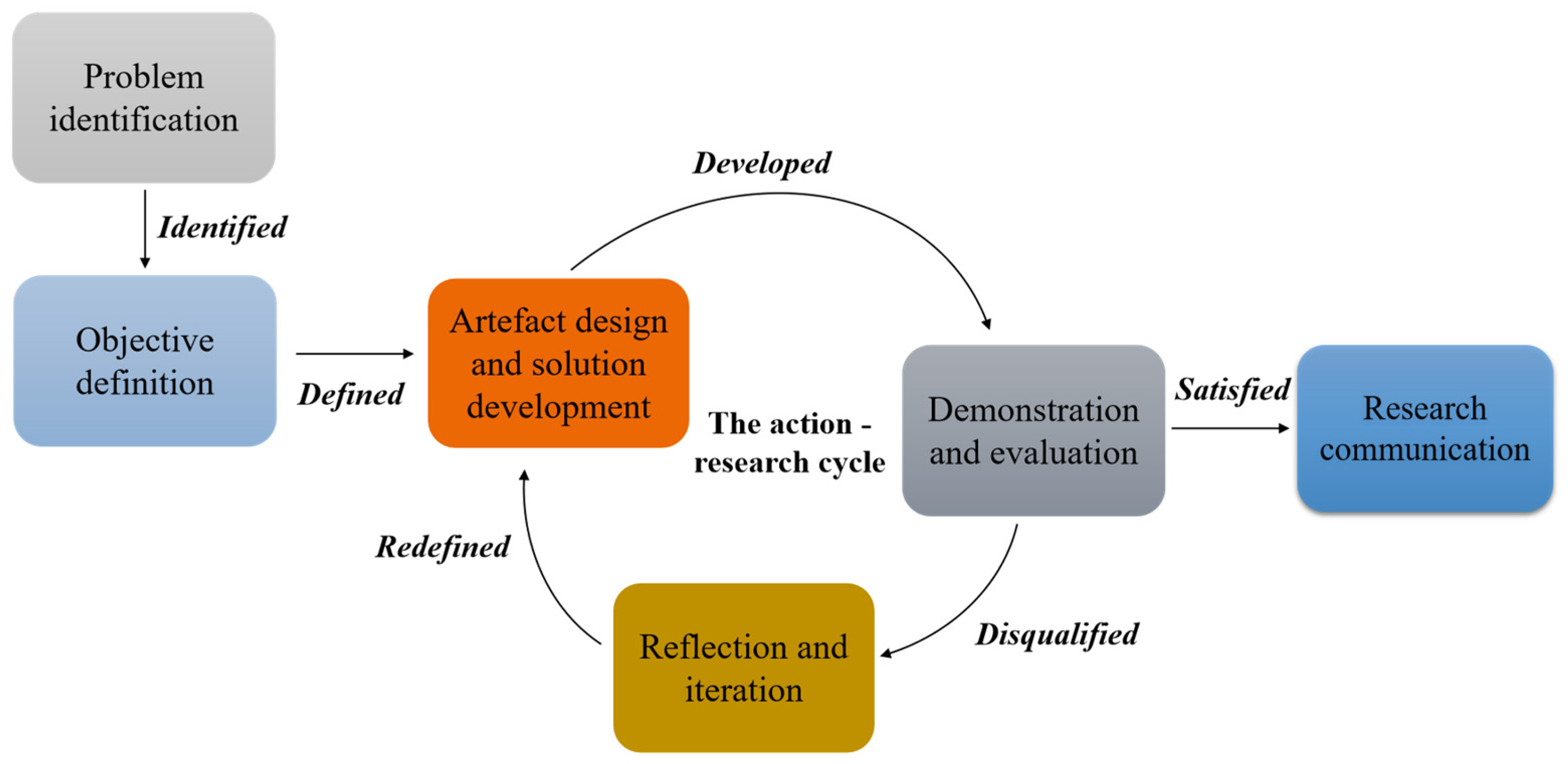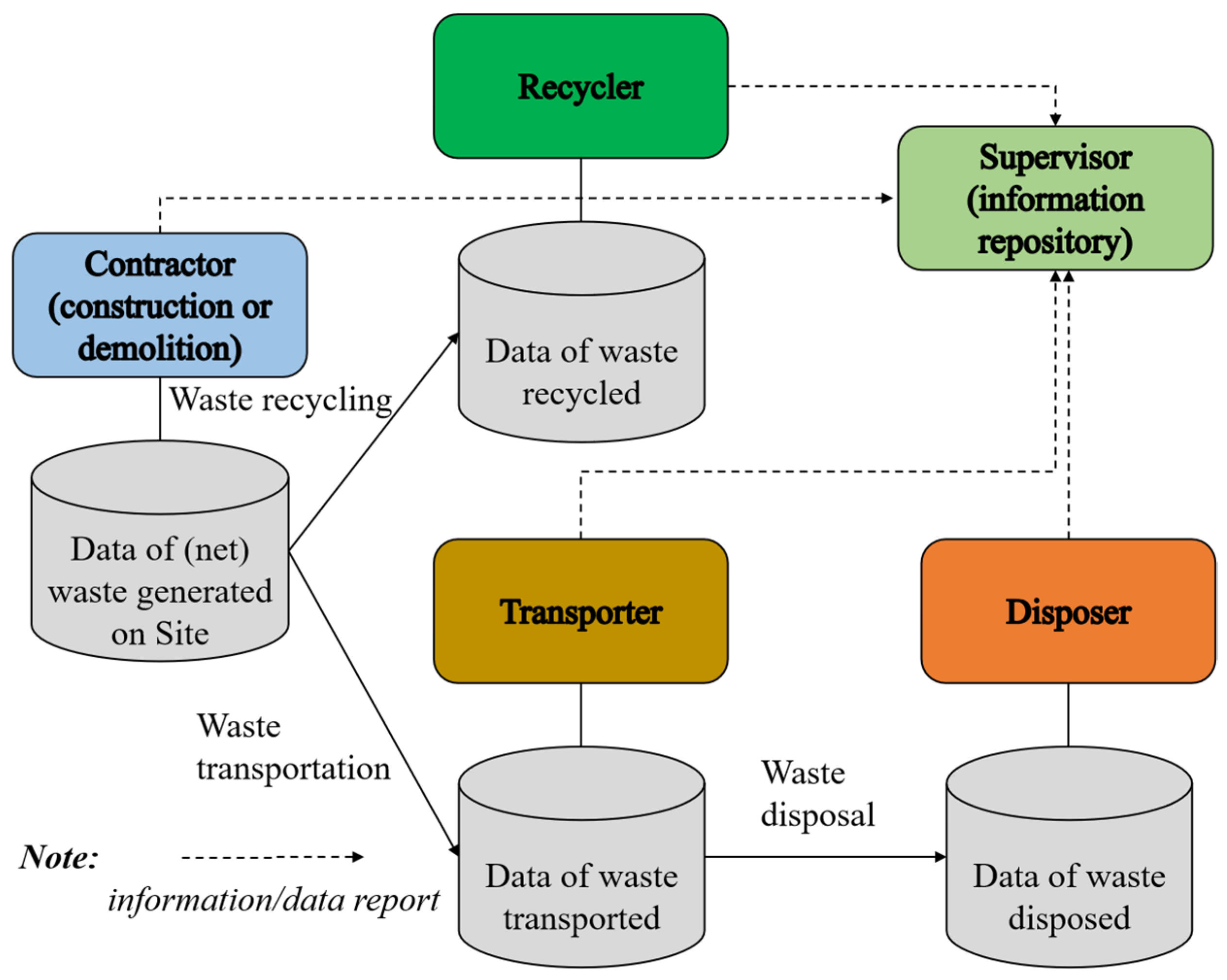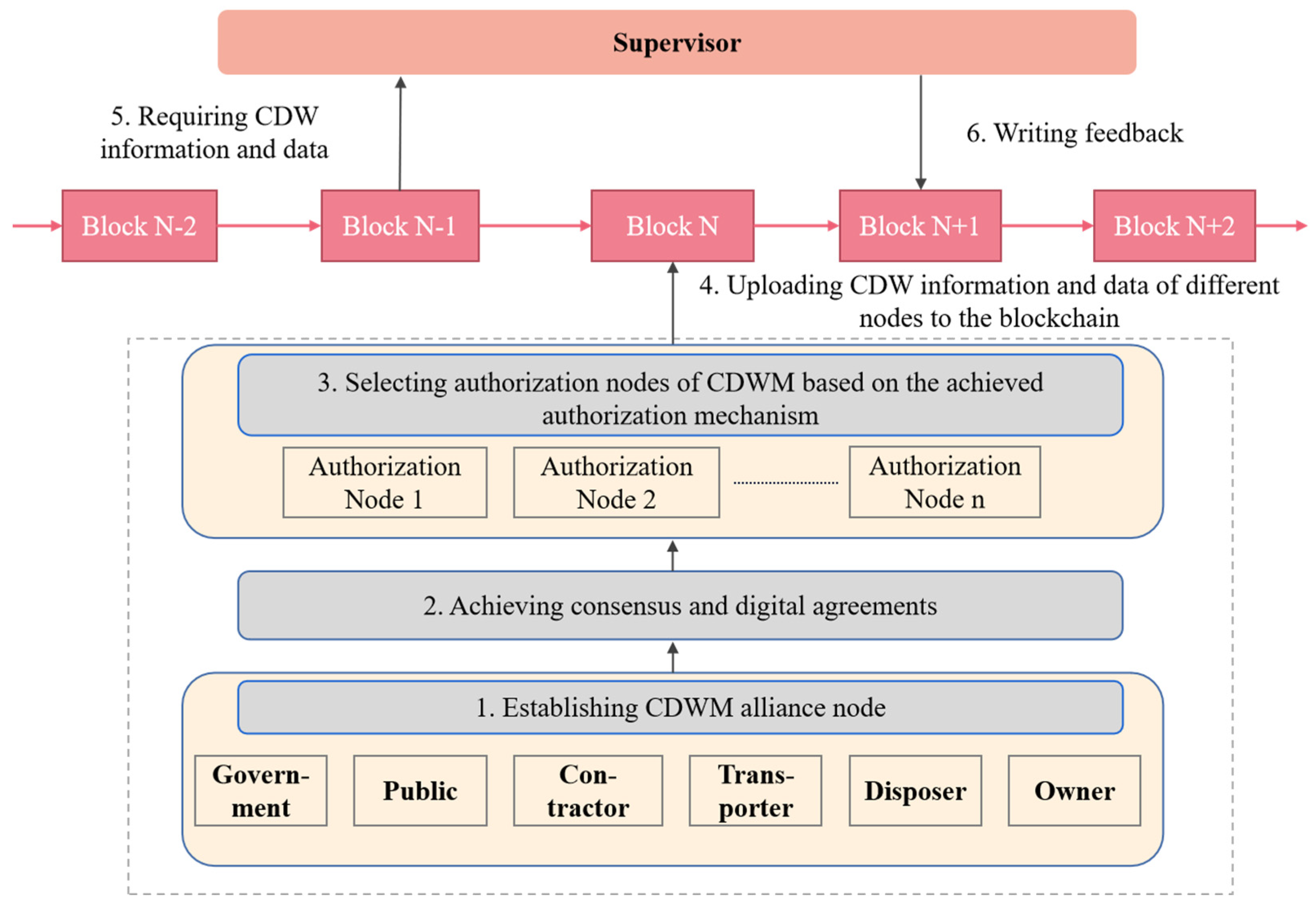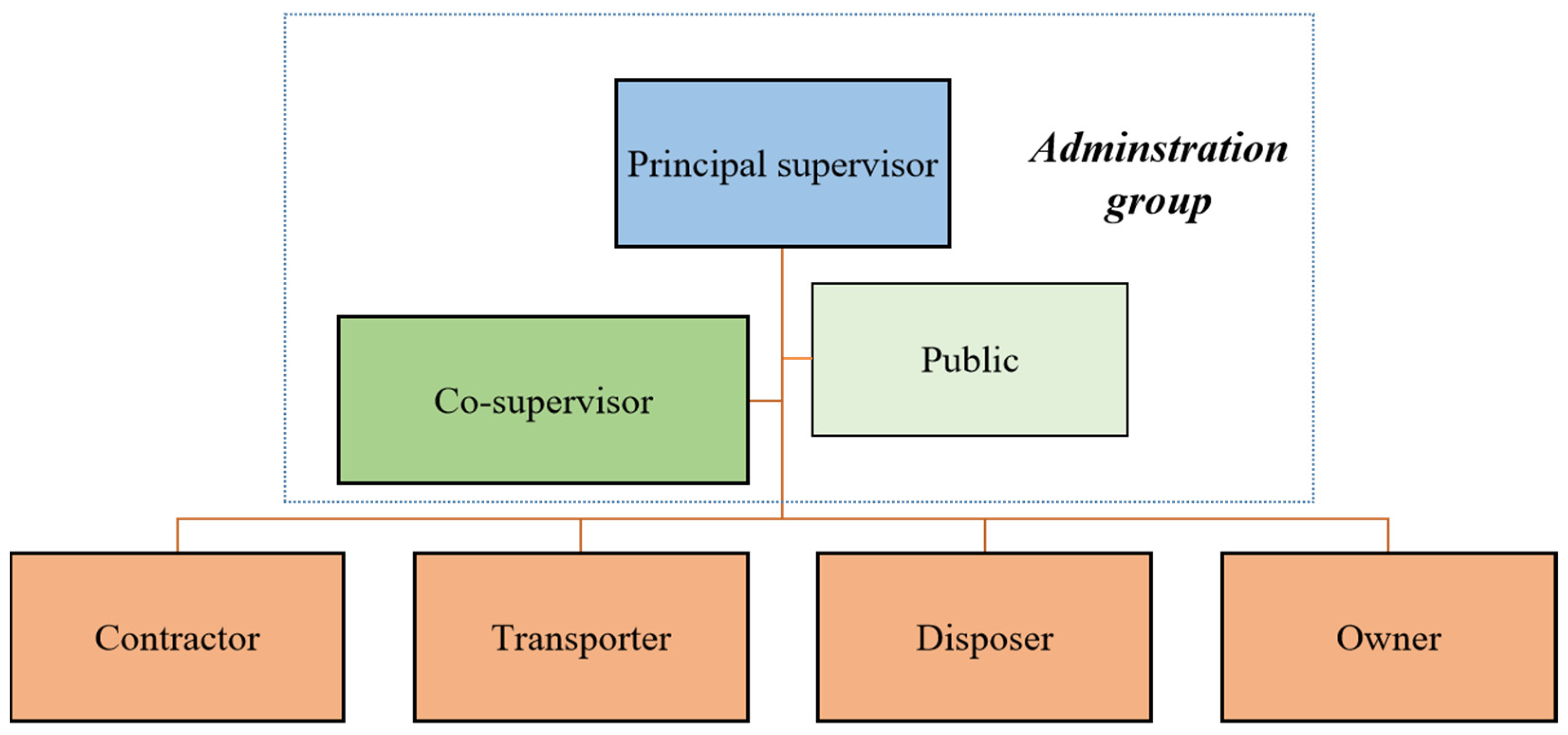Blockchain-Enabled Construction and Demolition Waste Management: Advancing Information Management for Enhanced Sustainability and Efficiency
Abstract
1. Introduction
2. Literature Review
2.1. Information Management in CDW Management and Administration
2.2. The Application of Blockchain in the Construction Industry and CDW Information Management
2.3. Research Gap in Blockchain-Enabled CDWM
3. Research Method
3.1. The Design Science Action Research
3.2. The Implementation of the Design Science Action Research
3.2.1. Problem Identification
3.2.2. Objective Definition
- (1)
- Identification and Encryption of Critical Information: Utilizing the blockchain’s robust encryption capabilities, this study aimed to identify and secure critical data in CDWM. This could enhance both transparency and security in data and information sharing, thereby addressing the principal–agent conflicts by mitigating the risks of information manipulation and mismanagement.
- (2)
- Establishment of a Blockchain-Enhanced Data Supply Framework: The second objective was to develop a blockchain-based framework that facilitates collaborative working and effective supervision within CDW information management. This framework could leverage blockchain’s inherent features, such as decentralized ledgers and smart contracts, to promote a more integrated and efficient data supply chain, thereby enhancing collaboration and oversight across different CDWM stakeholders.
3.2.3. Artefact Design and Solution Development
3.2.4. Demonstration and Evaluation
3.2.5. Reflection and Iteration
3.2.6. Research Communication
3.3. Addressing Research Method Limits
4. The Blockchain-Enabled CDWM Framework and the System Architecture of the Information System
4.1. Primary Principles of Blockchain-Enabled Information Tracking for CDWM
4.1.1. Data Supply Chain for CDWM
4.1.2. Main Functions to Employ Blockchain-Enhanced Data Supply Chain in the CDWM Context
4.1.3. Blockchain-Enhanced CDWM Framework
4.2. Integrating Blockchain into CDWM Information System
4.2.1. Organizational Structure
4.2.2. System Architecture
4.3. Major Impacts and Potential Problems of the Blockchain-Enhanced CDWM Information System
4.3.1. Major Impacts
4.3.2. Potential Problems
5. Discussion
5.1. Contributions
5.1.1. Theoretical Contributions
5.1.2. Practical Contributions
5.2. Potential to Improve CDWMIS with Blockchain Technology
5.3. Critical Analysis and Reflection on This Design Science Action Research
6. Conclusions
Author Contributions
Funding
Institutional Review Board Statement
Informed Consent Statement
Data Availability Statement
Conflicts of Interest
References
- Zhang, K.; Qing, Y.; Umer, Q.; Asmi, F. How construction and demolition waste management has addressed sustainable development goals: Exploring academic and industrial trends. J. Environ. Manag. 2023, 345, 118823. [Google Scholar] [CrossRef] [PubMed]
- Ogunmakinde, O.E.; Egbelakin, T.; Sher, W. Contributions of the circular economy to the UN sustainable development goals through sustainable construction. Resour. Conserv. Recycl. 2022, 178, 106023. [Google Scholar] [CrossRef]
- Kanafani, K.; Magnes, J.; Lindhard, S.M.; Balouktsi, M. Carbon emissions during the building construction phase: A comprehensive case study of construction sites in Denmark. Sustainability 2023, 15, 10992. [Google Scholar] [CrossRef]
- Ma, W.; Hao, J.L.; Zhang, C.; Di Sarno, L.; Mannis, A. Evaluating carbon emissions of China’s waste management strategies for building refurbishment projects: Contributing to a circular economy. Environ. Sci. Pollut. Res. 2023, 30, 8657–8671. [Google Scholar] [CrossRef]
- Liu, Z.; Osmani, M.; Demian, P.; Baldwin, A. A BIM-aided construction waste minimisation framework. Autom. Constr. 2015, 59, 1–23. [Google Scholar] [CrossRef]
- Lu, W.; Webster, C.; Chen, K.; Zhang, X.; Chen, X. Computational Building Information Modelling for construction waste management: Moving from rhetoric to reality. Renew. Sustain. Energy Rev. 2017, 68, 587–595. [Google Scholar] [CrossRef]
- Scott, D.J.; Broyd, T.; Ma, L. Exploratory literature review of blockchain in the construction industry. Autom. Constr. 2021, 132, 103914. [Google Scholar] [CrossRef]
- Elghaish, F.; Hosseini, M.R.; Kocaturk, T.; Arashpour, M.; Ledari, M.B. Digitalised circular construction supply chain: An integrated BIM-Blockchain solution. Autom. Constr. 2023, 148, 104746. [Google Scholar] [CrossRef]
- Sadeghi, M.; Mahmoudi, A.; Deng, X.; Luo, X. Prioritizing requirements for implementing blockchain technology in construction supply chain based on circular economy: Fuzzy Ordinal Priority Approach. Int. J. Environ. Sci. Technol. 2023, 20, 4991–5012. [Google Scholar] [CrossRef]
- Jalaei, F.; Zoghi, M.; Khoshande, A. Life cycle environmental impact assessment to manage and optimize construction waste using Building Information Modeling (BIM). Int. J. Constr. Manag. 2021, 21, 784–801. [Google Scholar] [CrossRef]
- Aslam, M.S.; Huang, B.; Cui, L. Review of construction and demolition waste management in China and USA. J. Environ. Manag. 2020, 264, 110445. [Google Scholar] [CrossRef] [PubMed]
- Li, C.Z.; Zhao, Y.; Xiao, B.; Yu, B.; Tam, V.W.; Chen, Z.; Ya, Y. Research trend of the application of information technologies in construction and demolition waste management. J. Clean. Prod. 2020, 263, 121458. [Google Scholar] [CrossRef]
- Cao, X.; Ding, Z. Management of municipal construction waste transportation by integrating ABM and GIS Model: A case study of Shenzhen. In Proceedings of the 25th International Symposium on Advancement of Construction Management and Real Estate, Wuhan, China, 28–30 November 2020; Springer: Singapore, 2021; pp. 235–253. [Google Scholar]
- Xu, J.; Shi, Y.; Xie, Y.; Zhao, S. A BIM-Based construction and demolition waste information management system for greenhouse gas quantification and reduction. J. Clean. Prod. 2019, 229, 308–324. [Google Scholar] [CrossRef]
- Siountri, K.; Skondras, E.; Vergados, D.D. Towards a smart museum using BIM, IoT, blockchain and advanced digital technologies. In Proceedings of the ICVISP 2019: 3rd International Conference on Vision, Image and Signal Processing, Vancouver, BC, Canada, 26–28 August 2019. [Google Scholar] [CrossRef]
- Celik, Y.; Petri, I.; Rezgui, Y. Leveraging BIM and blockchain for digital twins. In Proceedings of the 2021 IEEE International Conference on Engineering, Technology and Innovation, ICE/ITMC 2021, Cardiff, UK, 21–23 June 2021. [Google Scholar]
- Berawi, M.A.; Zagloel, T.Y.; Ariq, M.N.; Sari, M. A Blockchain-based BIM model for the smart building planning process. In Proceedings of the 3rd International Scientific Conference on Innovations in Digital Economy, Saint-Petersburg, Russia, 14–15 October 2022; pp. 253–261. [Google Scholar]
- Jiang, Y.S.; Liu, X.L.; Kang, K.; Wang, Z.C.; Zhong, R.Y.; Huang, G.Q. Blockchain-enabled cyber-physical smart modular integrated construction. Comput. Ind. 2021, 133, 103553. [Google Scholar] [CrossRef]
- Li, X.; Lu, W.S.; Xue, F.; Wu, L.P.F.; Zhao, R.; Lou, J.F.; Xu, J.Y. Blockchain-enabled IoT-BIM platform for supply chain management in modular construction. J. Constr. Eng. Manag. 2022, 148, 0002229. [Google Scholar] [CrossRef]
- Wu, L.; Lu, W.; Xue, F.; Li, X.; Zhao, R.; Tang, M. Linking permissioned blockchain to Internet of Things (IoT)-BIM platform for off-site production management in modular construction. Comput. Ind. 2022, 135, 103573. [Google Scholar] [CrossRef]
- Götz, C.S.; Karlsson, P.; Yitmen, I. Exploring applicability, interoperability and integrability of Blockchain-based digital twins for asset life cycle management. Smart Sustain. Built Environ. 2022, 11, 532–558. [Google Scholar] [CrossRef]
- Figueiredo, K.; Hammad, A.W.A.; Haddad, A. Improving sustainability in the built environment through a BIM-based integration of digital twin and blockchain: An analysis of prefabricated modular construction. In Cognitive Digital Twins for Smart Lifecycle Management of Built Environment and Infrastructure Challenges, Opportunities and Practices; CRC Press: Boca Raton, FL, USA, 2023; pp. 101–122. [Google Scholar]
- Shojaei, A.; Wang, J.; Fenner, A. Exploring the feasibility of blockchain technology as an infrastructure for improving built asset sustainability. Built Environ. Proj. Asset Manag. 2020, 10, 184–199. [Google Scholar] [CrossRef]
- Perera, S.; Nanayakkara, S.; Rodrigo, M.; Senaratne, S.; Weinand, R. Blockchain technology: Is it hype or real in the construction industry? J. Ind. Inf. Integr. 2020, 17, 100125. [Google Scholar] [CrossRef]
- França, A.; Neto, J.A.; Gonçalves, R.; Almeida, C. Proposing the use of blockchain to improve the solid waste management in small municipalities. J. Clean. Prod. 2020, 244, 118529. [Google Scholar] [CrossRef]
- Wu, L.; Lu, W.; Peng, Z.; Webster, C. A blockchain non-fungible token-enabled ‘passport’ for construction waste material cross-jurisdictional trading. Autom. Constr. 2023, 149, 104783. [Google Scholar] [CrossRef]
- Gregor, S.; Hevner, A.R. Positioning and presenting design science research for maximum impact. MIS Q. 2013, 37, 337–355. [Google Scholar] [CrossRef]
- Hartmann, T.; Fischer, M.; Haymaker, J. Implementing information systems with project teams using ethnographic–action research. Adv. Eng. Inform. 2009, 23, 57–67. [Google Scholar] [CrossRef]
- Peffers, K.; Tuunanen, T.; Rothenberger, M.A.; Chatterjee, S. A design science research methodology for information systems research. J. Manag. Inf. Syst. 2007, 24, 45–77. [Google Scholar] [CrossRef]
- Spremann, P.K. Agent and principal. In Agency Theory, Information, and Incentives; Springer: Berlin/Heidelberg, Germany, 1987; pp. 3–37. [Google Scholar]
- Sezer, A.A.; Bosch-Sijtsema, P. Actor-to-actor tensions influencing waste management in building refurbishment projects: A service ecosystem perspective. Int. J. Constr. Manag. 2022, 22, 1690–1699. [Google Scholar] [CrossRef]
- Akinade, O.O.; Oyedele, L.O.; Ajayi, S.O.; Bilal, M.; Alaka, H.A.; Owolabi, H.A.; Arawomo, O.O. Designing out construction waste using BIM technology: Stakeholders’ expectations for industry deployment. J. Clean. Prod. 2018, 180, 375–385. [Google Scholar] [CrossRef]
- Wieringa, R.J. Design Science Methodology for Information Systems and Software Engineering; Springer: Berlin/Heidelberg, Germany, 2014. [Google Scholar]
- Zhang, Y.; Wang, T.; Yuen, K. Construction site information decentralized management using blockchain and smart contracts. Comput.-Aided Civ. Infrastruct. Eng. 2022, 37, 1450–1467. [Google Scholar] [CrossRef]
- Yang, Z.; Zhu, C.; Zhu, Y.; Li, X. Blockchain technology in building environmental sustainability: A systematic literature review and future perspectives. Build. Environ. 2023, 245, 110970. [Google Scholar] [CrossRef]
- Li, J.; Kassem, M. Applications of distributed ledger technology (DLT) and Blockchain-enabled smart contracts in construction. Autom. Constr. 2021, 132, 103955. [Google Scholar] [CrossRef]
- Chauhan, C.; Parida, V.; Dhir, A. Linking circular economy and digitalisation technologies: A systematic literature review of past achievements and future promises. Technol. Forecast. Soc. Change 2022, 177, 121508. [Google Scholar] [CrossRef]
- Yang, X.; Zhang, R.; Yue, C.; Liu, Y.; Ooi, B.C.; Gao, Q.; Zhang, Y.; Yang, H. VeDB: A software and hardware enabled trusted relational database. Proc. ACM Manag. Data 2023, 1, 194. [Google Scholar] [CrossRef]
- Yang, X.; Zhang, Y.; Wang, S.; Yu, B.; Li, F.; Li, Y.; Yan, W. LedgerDB: A centralized ledger database for universal audit and verification. Proc. VLDB Endow. 2020, 13, 3138–3151. [Google Scholar] [CrossRef]
- Yang, X.; Wang, S.; Li, F.; Zhang, Y.; Yan, W.; Gai, F.; Yu, B.; Feng, L.; Gao, Q.; Li, Y. Ubiquitous verification in centralized ledger database. In Proceedings of the 2022 IEEE 38th International Conference on Data Engineering (ICDE), Kuala Lumpur, Malaysia, 9–12 May 2022; pp. 1808–1821. [Google Scholar]






| Actor | Category of CDWM Information and Data |
|---|---|
| Contractor | CDW generation quantity, time, person in charge, CDW material type, building or work-related information, etc. |
| Transporter | Vehicle and transportation quantity, time, person in charge, transportation trail, end space, etc. |
| Recycler | Received quantity, time, person in charge, CDW handling information, etc. |
| Disposer | Received quantity, time, person in charge, disposal site information, CDW disposal information, etc. |
| CDW Information Management Issues | Blockchain’s Function/Feature | References |
|---|---|---|
| Distorted information or data security | Information encryption | [7,24,26] |
| Lack of transparency | Distributed ledger | [7,8,34] |
| Miscellaneous checking procedures | Smart contract | [35,36] |
Disclaimer/Publisher’s Note: The statements, opinions and data contained in all publications are solely those of the individual author(s) and contributor(s) and not of MDPI and/or the editor(s). MDPI and/or the editor(s) disclaim responsibility for any injury to people or property resulting from any ideas, methods, instructions or products referred to in the content. |
© 2024 by the authors. Licensee MDPI, Basel, Switzerland. This article is an open access article distributed under the terms and conditions of the Creative Commons Attribution (CC BY) license (https://creativecommons.org/licenses/by/4.0/).
Share and Cite
Ma, X.; Yuan, H.; Du, W. Blockchain-Enabled Construction and Demolition Waste Management: Advancing Information Management for Enhanced Sustainability and Efficiency. Sustainability 2024, 16, 721. https://doi.org/10.3390/su16020721
Ma X, Yuan H, Du W. Blockchain-Enabled Construction and Demolition Waste Management: Advancing Information Management for Enhanced Sustainability and Efficiency. Sustainability. 2024; 16(2):721. https://doi.org/10.3390/su16020721
Chicago/Turabian StyleMa, Xiaozhi, Hongping Yuan, and Wenbo Du. 2024. "Blockchain-Enabled Construction and Demolition Waste Management: Advancing Information Management for Enhanced Sustainability and Efficiency" Sustainability 16, no. 2: 721. https://doi.org/10.3390/su16020721
APA StyleMa, X., Yuan, H., & Du, W. (2024). Blockchain-Enabled Construction and Demolition Waste Management: Advancing Information Management for Enhanced Sustainability and Efficiency. Sustainability, 16(2), 721. https://doi.org/10.3390/su16020721










